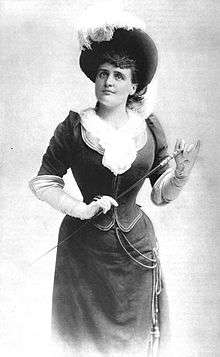Isabelle Urquhart
Isabelle Urquhart (December 9, 1865 – February 7, 1907) was an American stage actress and contralto, noted for her work in comic opera and musical comedy.

Biography
Urquhart was born in New York City and claimed to have been educated in a convent.[1][2]
On February 19, 1881, she made her first stage appearance, as a chorus girl in the Richard D'Oyly Carte and E. E. Rice Opera Companies' production of Billee Taylor at New York's Standard Theatre.[2][3] She had a small role in an opera called Elves and Mermaids, which lasted only three performances because the manager absconded with the box-office money.[1] She was also in the chorus in another D'Oyly Carte production, Claude Duval, the following season.
Afterwards, Urquhart signed on with Augustin Daly's company from 1882 to 1883, acting in The Passing Regiment, Needles and Pins, and The Squire.[2] In The Squire, the then 17-year-old played a 97-year-old woman, not without some reservations.[1] She was persuaded to return to light opera because it paid better, though she stated in an interview that "I prefer legitimate drama to comic opera".[1] Nonetheless, she had much success, with major roles in the genre, including the hit operetta Erminie, which ran from 1886 to 1888 at the Casino Theatre; Gilbert and Sullivan's The Yeomen of the Guard (1888), as Dame Carruthers; and W. S. Gilbert's translation of Offenbach's Les brigands (1889), as the Princess of Granada.[3] As a leading lady in Erminie, according to a theatre program, she started a fashion trend by foregoing her petticoats "to accentuate her gorgeous figure".[4]
Urquhart also appeared in vaudeville. In 1897, she performed a sketch of her own devising at the Union Square Theatre, in which she "did little more ... than display her form in a handsome gown to the utmost advantage".[5] She later performed in several Broadway plays: The Diplomat (1902), Arms and the Man (1906), and How He Lied to Her Husband (1906).
Urquhart was married for six years to Guy Standing, eight years her junior, from 1893 until they divorced.
She was stricken with peritonitis on January 21, 1907. Two operations failed to save her, and she died on February 7, 1907, in Rochester, New York.[2]
References
- Dale, Alan (1890). Familiar chats with the queens of the stage. New York: G. W. Dillingham. Retrieved September 16, 2009.
- "ISABELLE URQUHART DEAD" (PDF). New York Times. February 8, 1907. Retrieved September 16, 2009.
- Stone, David. Belle Urquhart at Who Was Who in the D'Oyly Carte Opera Company, August 27, 2001, accessed June 26, 2010
- "This is the Francis Wilson Playhouse "But Who Was Francis Wilson?"" (PDF). Archived from the original (PDF) on June 19, 2006. Retrieved September 16, 2009.
- Erdman, Andrew L. (2004). Blue Vaudeville: Sex, Morals and the Mass Marketing of Amusement, 1895-1915. Jefferson, N.C.: McFarland Co. ISBN 0-7864-1827-3. p. 87
External links
- Isabelle Urquhart at the Internet Broadway Database

- Photographs, New York Public Library
- Photograph circa 1902, Ekstrom Library, University of Louisville
- Photograph, Furness Image Collection, University of Pennsylvania
- Portrait and bio